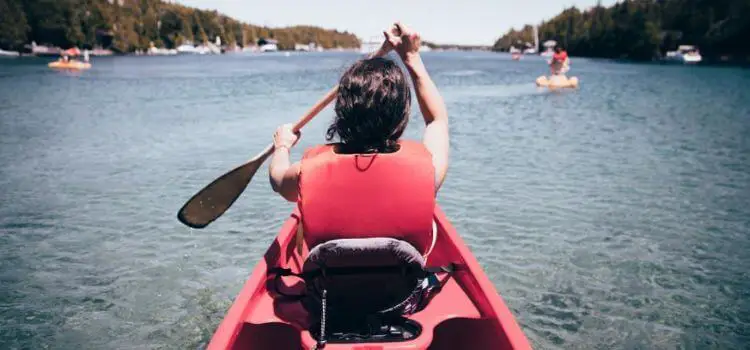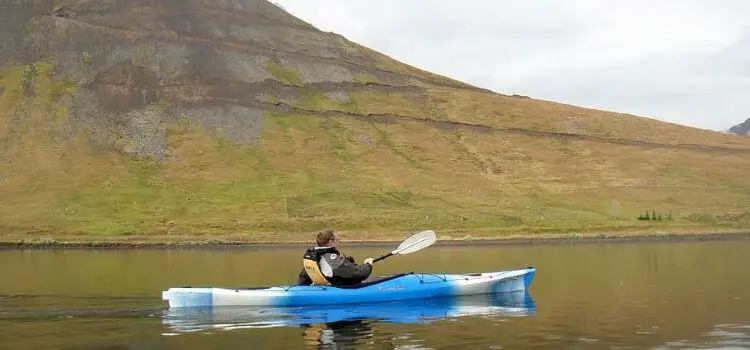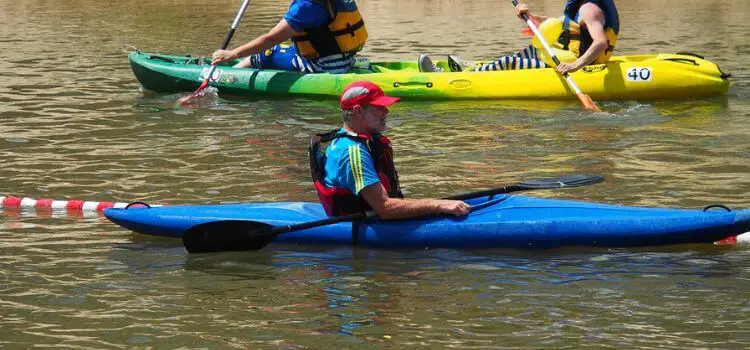As an Amazon Associates, I earn from quality purchases.
Have you ever wondered how to kayak faster? If so, we’ve got you covered! In this article, we will explore some techniques and strategies to help you kayak faster and enhance your overall performance.
In short, the key to kayaking faster lies in mastering your paddling technique and harnessing the power of your strokes. By focusing on precise paddle placement and maximizing each stroke’s efficiency, you can significantly increase your speed without expending unnecessary energy.
But these strategies are just the tip of the iceberg. Let’s equip you with the knowledge and tools to make every paddle stroke count. Let’s get started!
How far can the average person kayak in a day?
The distance the average person can kayak in a day depends on various factors such as their experience, fitness level, type of kayak, environmental conditions, and the difficulty of the route.
On a calm day with favorable conditions, an experienced kayaker in a racing kayak may cover anywhere from 20 to 40 miles (32 to 64 kilometers) in a day. However, for recreational paddlers or those kayaking for leisure and enjoyment, the average distance may range from 5 to 15 miles (8 to 24 kilometers) per day.
These distances are approximate and can vary based on the factors mentioned above. Beginners may not be able to kayak long distances initially. But they can gradually increase their distance with practice and skill development.
How fast does the average person kayak?

The average speed at which the average person kayaks can vary depending on the factors mentioned above. As a general guideline, recreational kayakers and those kayaking for leisurely purposes tend to average speeds between 2 to 4 miles per hour (3.2 to 6.4 kilometers per hour).
For more experienced paddlers or those engaged in training or racing, speeds can range between 4 to 6 miles per hour (6.4 to 9.7 kilometers per hour) or even higher, depending on the individual’s skill level, fitness, and the type of kayak used.
It’s important to note that these speed ranges are approximate and can vary based on individual circumstances and conditions.
Factors Affecting Kayak Speed
Several factors influence the speed of a kayak. Let’s talk about each of them:
Type of Kayak
The type of kayak plays a significant role in determining its speed. Different kayak designs are optimized for specific purposes, and their hull shapes, lengths, and widths vary accordingly. For example, racing kayaks are often longer, narrower, and more streamlined to minimize drag and increase speed. On the other hand, recreational kayaks, which prioritize stability and maneuverability, tend to be wider and slower.
Paddler’s Skill Level
The skill level of the paddler directly affects the kayak’s speed. Experienced paddlers who have mastered efficient paddling techniques can generate more power and maintain a consistent rhythm, resulting in higher speeds. Novice paddlers may struggle to achieve the same level of efficiency and speed initially but can improve with practice and training.
Environmental Conditions
Environmental conditions, such as wind, currents, and waves, have a significant impact on kayak speed. Headwinds can slow down a kayak’s progress, while tailwinds can provide a speed boost. Similarly, strong currents can either assist or impede a paddler’s speed. Waves and choppy water can also affect stability and efficiency, impacting overall speed.
Paddling Techniques
Proper paddling techniques contribute to increased kayak speed. Efficient paddle strokes, body positioning, and timing are crucial. By utilizing core muscles, engaging in torso rotation, and optimizing stroke length, a paddler can generate more power and maintain a consistent pace.
Speed Range for Different Kayaks
The speed range of a kayak can vary depending on its design and intended use. Here’s an overview of the speed ranges for different types of kayaks:
Recreational Kayaks
Recreational kayaks, designed for leisurely paddling and stability, typically have lower speed capabilities. On average, recreational kayaks can achieve speeds ranging from 2 to 4 miles per hour (3.2 to 6.4 kilometers per hour). These kayaks prioritize ease of use and maneuverability over maximum speed.
Touring Kayaks
Touring kayaks, often used for longer trips and exploring waterways, offer a balance between speed and stability. They can reach speeds ranging from 4 to 6 miles per hour (6.4 to 9.7 kilometers per hour). Touring kayaks are designed for efficiency and comfort during extended paddling sessions.
Sea Kayaks
Sea kayaks are built to handle open water conditions and cover longer distances. With their sleek and efficient designs, sea kayaks can achieve speeds ranging from 5 to 7 miles per hour (8 to 11.3 kilometers per hour). These kayaks prioritize speed, stability, and maneuverability in challenging sea environments.
Racing Kayaks
Racing kayaks, specifically designed for competitive racing, are the fastest type of kayaks. These high-performance kayaks can reach impressive speeds, averaging between 6 to 10 miles per hour (9.7 to 16.1 kilometers per hour). Racing kayaks feature ultra-lightweight constructions, narrow widths, and sleek hull designs to maximize speed and minimize drag.
Tips for Increasing Kayak Speed

If you’re looking to increase your kayak speed, consider the following tips:
Choosing the Right Kayak
Selecting the right kayak is essential for improving your speed. Consider the length, width, and hull design of the kayak. Longer kayaks tend to have better tracking and higher top speeds. Narrower kayaks offer less resistance in the water, allowing for faster paddling. Additionally, kayaks with a sleek hull design and minimal rocker are more efficient, enabling you to glide through the water with ease.
Mastering the Basic Techniques
Proper Paddling Technique
Mastering the correct paddling technique is fundamental to kayaking faster. Start by positioning yourself properly in the kayak, ensuring a stable and balanced posture. Grip the paddle with both hands, keeping them shoulder-width apart. Engage your core muscles and rotate your torso as you paddle, using your arms and upper body to generate power. Maintain a smooth and fluid motion, avoiding unnecessary strain or tension.
Optimizing Your Stroke
To maximize your speed, focus on optimizing your paddle stroke. Start by fully immersing the paddle blade in the water and pulling it back along the side of the kayak. Use your core muscles to rotate your torso and generate power, rather than relying solely on your arms. Maintain a high cadence with quick, efficient strokes, minimizing any unnecessary movements. Practice this technique to develop muscle memory and improve your efficiency on the water.
Improving Physical Fitness
Enhancing your physical fitness is crucial for kayaking faster. The following areas should be the focus of your training routine:
Strength Training
Incorporate strength training exercises into your routine to develop the muscles necessary for powerful paddling. Focus on exercises that target the upper body, core, and back muscles. Examples include push-ups, pull-ups, planks, and rows. Building strength in these areas will help you generate more power and maintain speed over longer distances.
Endurance Training
Kayaking requires stamina and endurance. Include cardiovascular exercises such as swimming, running, or cycling in your training regimen. These activities improve your cardiovascular fitness, allowing you to paddle at a faster pace for an extended period. Gradually increase the duration and intensity of your workouts to build endurance.
Core Exercises
A strong core is essential for stability, balance, and efficient paddle strokes. Incorporate core exercises such as sit-ups, Russian twists, and leg raises into your fitness routine. A strong core will enable you to maintain proper body positioning, transfer power effectively, and navigate through challenging conditions with ease.
Enhancing Efficiency
Efficiency plays a vital role in kayaking faster. Here are some strategies to enhance your efficiency on the water:
Streamline Your Kayak
Reduce drag and improve speed by streamlining your kayak. Remove any unnecessary gear or accessories that create resistance in the water. Ensure that the kayak is properly balanced and trimmed to maintain optimal performance. Consider investing in a lightweight paddle that minimizes fatigue and allows for a more efficient stroke.
Body Positioning
Maintaining the correct body positioning while kayaking is crucial for speed. Maintain an upright position with a calm posture, activating your core muscles to ensure stability. Keep your feet and knees in contact with the kayak, allowing for better control and power transfer. Avoid excessive movements or leaning, as they can disrupt your balance and slow you down.
Stroke Timing
Timing your paddle strokes correctly is essential for maintaining a consistent speed. Coordinate your strokes with the rotation of your torso, ensuring a smooth and rhythmic motion. Avoid rushing or lagging in your stroke timing, as it can disrupt your momentum and decrease efficiency. Practice regularly to develop a natural and efficient stroke rhythm.
Training Drills for Speed
To improve your speed, incorporate the following training drills into your routine:
Interval Training
Interval training consists of alternating between intense bursts of activity and periods of active recovery. Paddle at maximum effort for a set distance or time, followed by a slower-paced recovery period. Perform this sequence multiple times throughout your training sessions. Interval training enhances your anaerobic capacity and improves your ability to sustain high speeds.
Sprint Training
Sprint training focuses on short bursts of maximum effort. Choose a specific distance, such as 100 meters, and paddle at your maximum speed. Rest for a short period and repeat the sprint multiple times. Sprint training improves your explosiveness, speed, and accelerative power.
Race Simulations
Simulate race conditions during your training sessions. Set up markers or buoys at different distances and paddle at a race pace. Practice maintaining speed, navigating turns, and overtaking competitors. Race simulations help you familiarize yourself with the demands of competitive kayaking and improve your ability to perform under pressure.
Mental Preparation
Enhancing your mental focus and preparation is vital for achieving faster speeds in kayaking. Consider the following strategies:
Visualize Success h4
Before getting on the water, visualize yourself kayaking at high speeds with precision and efficiency. Imagine yourself overcoming obstacles, maintaining a steady rhythm, and crossing the finish line first. Visualization techniques help enhance your confidence and prepare your mind for optimal performance.
Focus and Concentration
Maintain focus and concentration throughout your kayaking sessions. Block out distractions and immerse yourself fully in the present moment. Concentrate on your technique, stroke rhythm, and the sensations of being on the water. By staying focused, you can react quickly to changing conditions and make adjustments for improved speed.
Tips to Improve Paddling Technique for Speed

Proper Body Position and Posture:
Maintaining the correct body position and posture is crucial for efficient paddling. Follow these guidelines:
- Maintain an upright position with a straight back and relaxed shoulders.
- Keep your feet comfortably positioned on the footrests or braces.
- Maintain a slight forward lean from your hips to engage your core muscles.
Effective Grip and Hand Placement
Proper grip and hand placement on the paddle are essential for maximizing power and control. Consider the following:
- Hold the paddle with a loose grip, allowing for fluid movement.
- Place your hands slightly wider than shoulder-width apart on the paddle shaft.
- Position your top hand above your eye level and your bottom hand at chest level.
Engaging Core Muscles for Power
Your core muscles are key contributors to generating power in kayaking. Focus on activating your core:
- Engage your abdominal muscles by bracing your core.
- Initiate each stroke by rotating your torso, using your core as a source of power.
- Maintain a stable and balanced position, utilizing your core for stability.
Utilizing the Proper Stroke Technique
Mastering the correct stroke technique is vital for efficient and powerful paddling. Consider the following tips:
- Start each stroke by immersing the paddle fully in the water.
- Pull the paddle back in a straight line, close to the kayak’s hull.
- Rotate your torso and engage your core as you extend your stroke.
- Exit the paddle smoothly from the water at your hip, ready for the next stroke.
Maintaining a High Cadence
A high cadence, or paddle stroke rate, can contribute to increased speed. Focus on maintaining a rapid yet controlled rhythm:
- Strive for a consistent and quick paddle stroke rate.
- Avoid excessive pauses between strokes.
- Develop a smooth and efficient paddling rhythm.
Common Mistakes to Avoid
To further improve your paddling technique for speed, be mindful of these common mistakes:
- Avoid gripping the paddle too tightly, as it can restrict your range of motion and cause fatigue.
- Steer clear of leaning too far forward or backward, as it can disrupt your balance and stability.
- Refrain from using only your arms for paddling; engage your core and larger muscle groups for increased power.
Related Topics:
1. How to Make a Kayak Track Better?
2. What is a Good CFS for Kayaking?
Final Words!
Kayaking faster requires a combination of technique, physical fitness, and mental preparation. By implementing the tips and strategies outlined in this article, you can enhance your speed, efficiency, and overall performance on the water.
Remember to practice consistently, maintain a positive mindset, and stay committed to your goals. With dedication and perseverance, you’ll become a faster and more proficient kayaker.
FAQs
Q: How long does it take to kayak 10 miles?
A: The time it takes to kayak 10 miles can vary depending on factors such as your paddling speed, environmental conditions, and your level of kayaking experience. On average, paddling at a leisurely pace can take approximately 2 to 4 hours to cover a distance of 10 miles.
Q: How fast do Olympic kayakers go?
A: Olympic kayakers are incredibly skilled and trained athletes who can achieve impressive speeds on the water. While the exact speed can vary, top Olympic kayakers can reach speeds of 12 to 15 miles per hour during their races.
Q: Can you kayak 30 miles in a day?
A: Yes, it is possible to kayak 30 miles in a day. However, the feasibility of covering such a distance in a single day depends on various factors, including your fitness level, experience, weather conditions, and the type of kayak you’re using. It is essential to plan and prepare adequately, taking breaks, hydrating, and considering factors like tidal currents and wind to ensure a safe and enjoyable journey.
Q: Can I kayak faster with a wider kayak?
A: Generally, narrower kayaks offer less resistance and allow for faster speeds. However, stability can be compromised in extremely narrow kayaks, so it’s important to find the right balance based on your skill level and preferences.
Q: How long does it take to kayak faster?
A: Improving your kayaking speed is a gradual process that requires consistent practice and training. The time it takes to see significant improvements will vary depending on your starting point, effort, and dedication.
Q: Are there any specific stretches to improve kayaking speed?
A: Stretching is essential to maintain flexibility and prevent injuries. Focus on stretches that target your upper body, lower back, and hips. Incorporate exercises such as shoulder rolls, trunk rotations, and hip flexor stretches into your warm-up and cool-down routines.

Leave a Reply